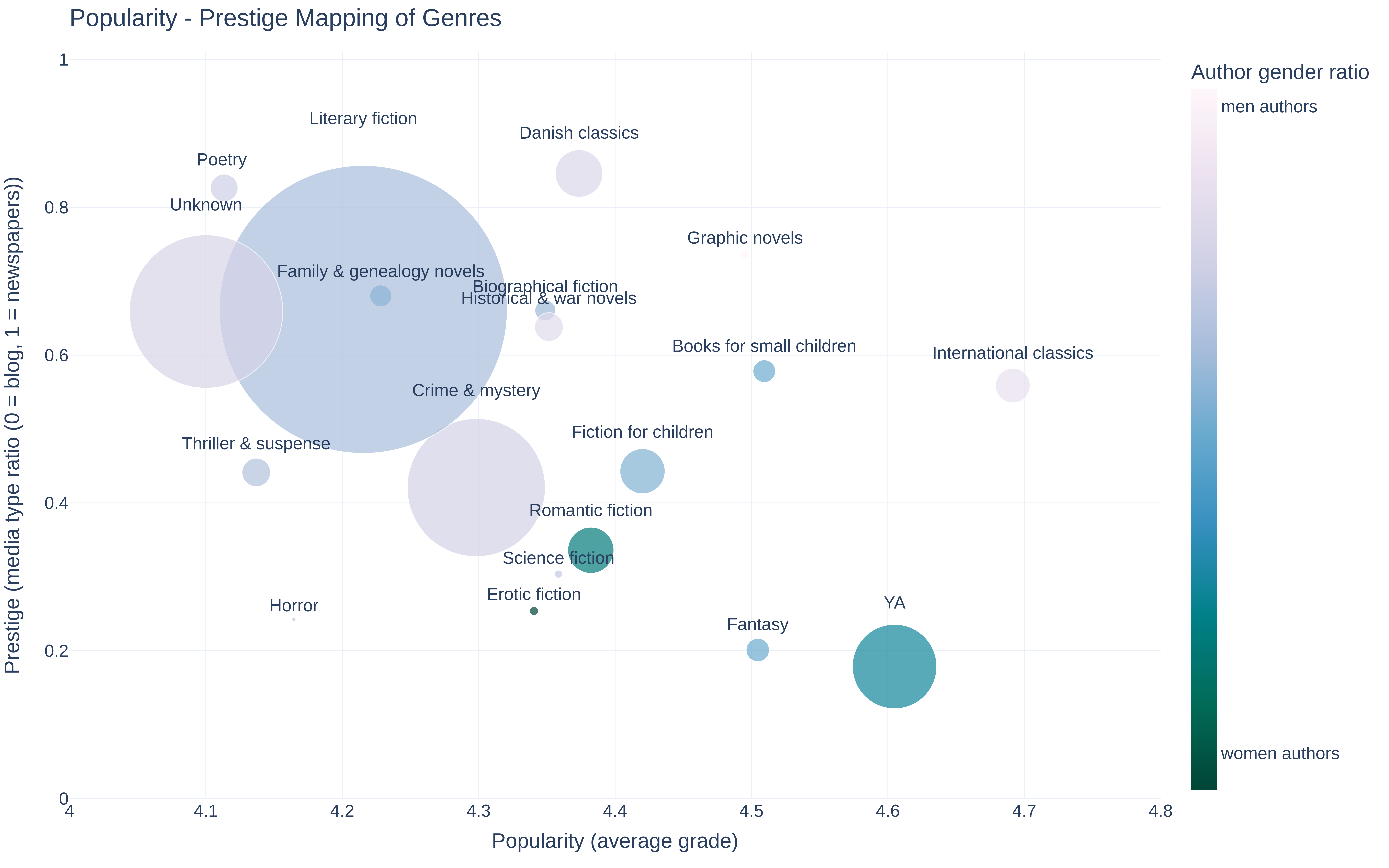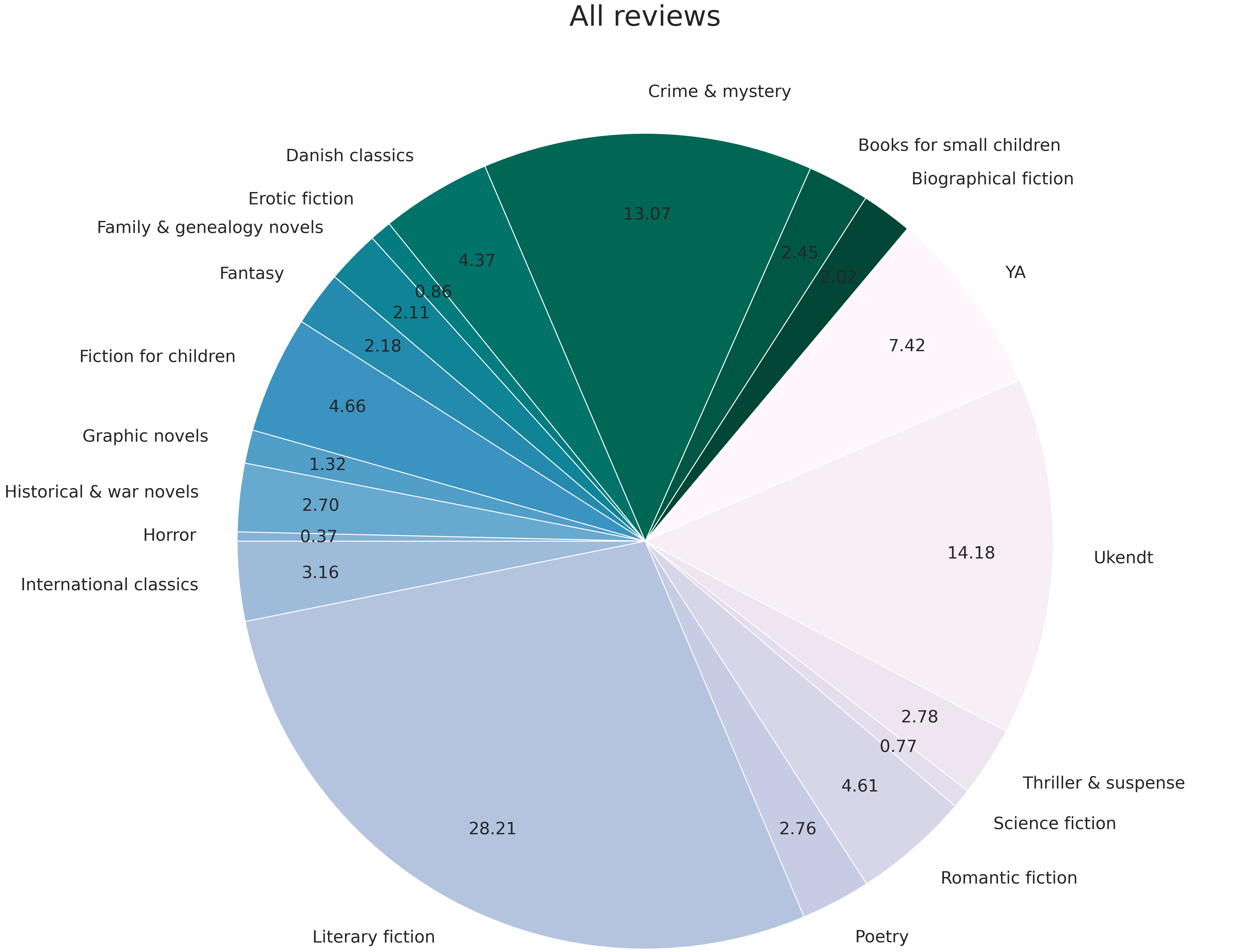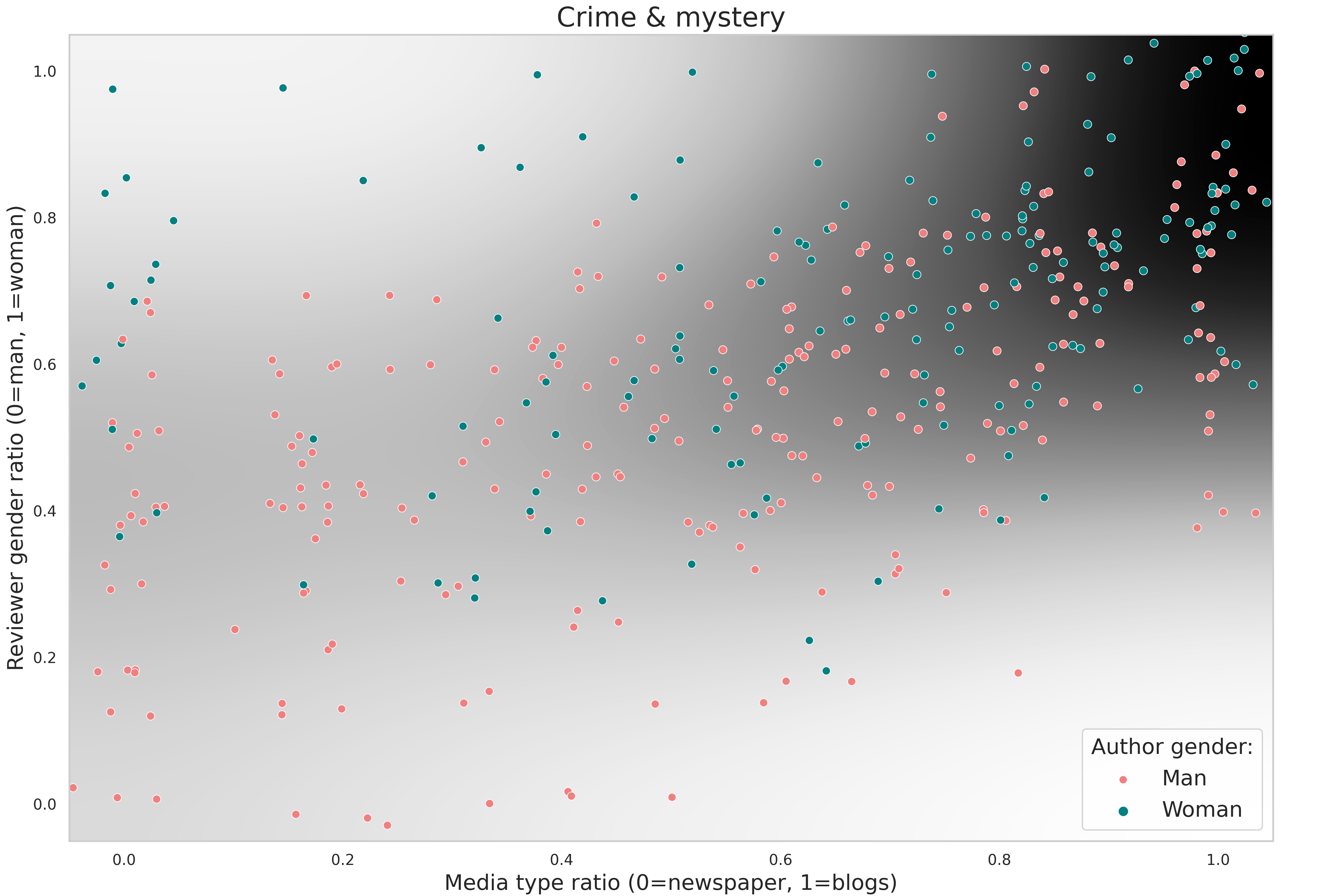In our most recent study, we found that there seem to be substantial gender asymmetries within and across literary genres that pertain to both the readers and writers: genres are both rated differently (more prestigious genres are rated higher), but reviewer behavior is also different across genres and media, in newspapers and blogs. Our results show that reviews in Danish media are polarized between the reviewer genders and the two media types, upholding additional gender asymmetries in rating.

Mapping popularity and prestige in the field of Danish literary reviews. The popularity is the average rating in reviews, and prestige is the ratio between newspaper and blog reviews. The size of the circles corresponds to the total number of reviews within each genre, and the colors represent the gender distribution of author gender on the number of published reviews of each genre.
Gender biases and genre biases
In 2022, with our study on gender imbalances in Danish literary reviews (Lassen et al., 2022), we showed that there appears to be structural gender biases. At the time, we worked on a large dataset that spanned different genres, with information about the media (newspaper or blog) and reviewer gender. We found that preferences for a particular author-gender were linked to the gender majority within each media type: men are the predominant reviewers and authors in newspapers, while women are similarly dominant in blogs. This intricate interplay between old and new media highlights the complex nature of social biases in the cultural sphere – and the literary genre of works adds further complexities to the study of book reviews. Men and women read, review, and publish in different genres. For example, women mainly publish romantic fiction, children’s literature, and young adult fiction, whereas men dominate genres such as crime, thriller, and adventure (Thelwall, 2019). Therefore, when studying gender asymmetries in reviews, an analysis not considering genres will risk inferring gender preferences from genre preferences. Women authors may get worse reviews because they write in genres that overall get worse reviews or are less “prestigious”. For example, works in what we might loosely call “general fiction” or “literary novel” may get better reviews overall, and women authors just write more in other genres. As such, considering literary genres and the gender distribution within and across genres provides a more nuanced picture of gender biases. Building on our previous work, we therefore set out to study differences in prestige and gender asymmetries across genres, looking at differences across genre and media type in our large corpus of reviews and the interaction between author- and reviewer-gender.
Tagging genre in an uneven literary field
In total, we worked with 12,996 unique book titles and 45,000 reviews, using 18 genre tags. Genre is a volatile concept, which reflects both the thematic and formal assessments of the work that is often the job of a publisher or critic while also reflecting implicit quality judgments made by these same persons. Because a genre-tag is a product of processes in the literary field and connected to literary prestige, if we try to assign genre exclusively from the content of books, our genres may not correspond to actual genres assigned by actors in the literary field. Instead, and since we were interested in how these books are treated on the literary market, we used the DK-5 genre tags or ‘theme codes’ assigned by publishers in Denmark. These are connected to each ISBN on the large online bookshop Saxo. We also estimated more canonical literature to make up a Danish and International “classics” genre, using canonicity lists and estimating canonicity by how often works are assigned on college syllabi (using the OpenSyllabus resource).

To examine how often works in specific genres and by each author-gender were reviewed, we first looked at the proportion of titles and reviews across genres and gender. For newspaper reviews, we found that the proportion between reviews and titles of women authors is most unequal for genres like ‘Danish classics’ and ‘Poetry,’ which are connected to high prestige (Porter, 2018). In blogs, the opposite seems to be the case, where men authors consistently reviewed disproportionately less (i.e., the red bar in line Fig. 4 tends to be longer than the pink). In sum, we find opposite tendencies in newspapers compared to blogs when looking at the proportion of reviews. Moreover, we found that this is connected to men predominantly review newspapers and women in blogs. Distinguishing between books by men and women authors, we see that reviewers generally prefer authors of their own gender, with men favoring newspapers and women blogs., which aligns with our earlier research (Lassen et al., 2022). This trend can partly be explained by a breakdown of media types, indicating that genres with more women authors receive increased attention in blogs, while genres dominated by male authors receive more coverage in newspapers.

Proportion of women/men authors within genres and between on media type. From left to right, 1) in blogs, 2) in newspapers
Looking into specific genres: ‘Crime & Mystery’ and ‘International classics’
To gain a more in-depth understanding, we examined each genre separately. Plotting media ratio (𝑥-axis) against gender ratio (𝑦-axis) reveals the review landscape for each genre. Across all 18 genres, a concentration of reviews is evident in the corners, indicating male reviewers in newspapers and female reviewers in blogs. Additionally, when considering books by male and female authors, reviewers predominantly assess books from their own gender, consistent with our findings in Lassen et al. (2022).


By plotting reviewer-gender ratio and media type ratio, provides an overview of how each genre is reviewed. The colors of the dots furthermore indicate authors-gender, and we observe that reviewers of both genders mostly review books written by their own gender.
The genres ‘Crime & Mystery’ and ‘International classics’ are presented above, showing that for ‘Crime & Mystery’ newspapers predominantly feature reviews of crime novels by male authors and male reviewers, while blogs, led mainly by women reviewers, show more diverse preferences regarding author gender. For the genre ‘International classics, we observe that men review in newspapers and women review in blogs. Reviewers show a preference for same-gender authors in both media types.
Examining the ratings in each of the genre categories, we find that newspaper reviews of ‘Crime & Mystery’ books mirror the results found on all reviews in newspapers (Lassen et al., 2022), where women reviewers rate women authors the lowest and men reviewers the highest - and the opposite for blog reviews. We also observe that the genre ‘International classics’ is rated similarly in the two media types. This indicates that the effect of gender differs not only between the media types but also across different genre categories. The analysis of individual genres reveals a consistent pattern: women authors tend to receive lower ratings from women reviewers, and men authors get higher ratings from men reviewers. Moreover, women dominate in the genres, which are low-prestige genres (primarily reviewed in blogs). Conversely, men dominate in genres at the high-prestige end of the spectrum (primarily reviewed in newspapers).
Our findings highlight an ongoing issue of gender biases, not just emphasizing the structural nature of these imbalances, such as the divide between men and women, but also the cultural aspects of prestige and popularity that we see through the genre-tags, corresponding to a popular-highbrow divide in the literary field.
Read the full paper here: https://ceur-ws.org/Vol-3558/paper297.pdf
References
Lassen, I. M. S., Bizzoni, Y., Peura, T., Thomsen, M. R., & Nielbo, K. L. (2022). Reviewer Preferences and Gender Disparities in Aesthetic Judgments. CEUR Workshop Proceedings, 280–290. https://ceur-ws.org/Vol-3290/short_paper1885.pdf
Lassen, I. M. S., Moreira, P. F., Bizzoni, Y., Thomsen, M. R., & Nielbo, K. L. (2023). Persistence of Gender Asymmetries in Book Reviews Within and Across Genres. CEUR Workshop Proceedings, 14–28.
Porter, J. D. (2018). Popularity/Prestige. In Pamphlets of the Stanford Literary Lab 17. https://litlab.stanford.edu/LiteraryLabPamphlet17.pdf
Thelwall, M. (2019). Reader and author gender and genre in Goodreads. Journal of Librarianship and Information Science, 51(2), 403–430. https://doi.org/10.1177/0961000617709061